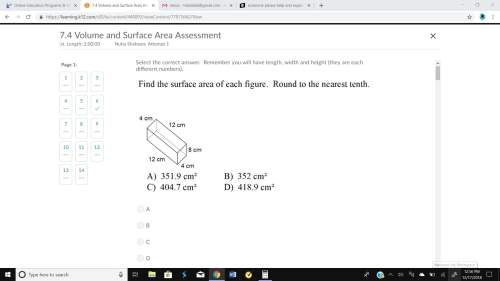
Mathematics, 11.12.2021 19:20 Darkphyx
HEL A triangle has vertices at B(−3, 0), C(2, −1), D(−1, 2). Which transformation would produce an image with vertices B″(1, −2), C″(0, 3), D″(3, 0)? (x, y) → (x + 1, y + 1), (x, y) → (y, x) (x, y) → (x + 1, y + 1), (x, y) → (−x, y), (x, y) → (x, −y), (x, y) → (x + 2, y + 2) (x, y) → (−x, y), (x, y) → (x + 2, y + 2)

Answers: 3


Another question on Mathematics

Mathematics, 21.06.2019 14:50
Polygon mnopq is dilated by a scale factor of 0.8 with the origin as the center of dilation, resulting in the image m′n′o′p′q′. the coordinates of point m are (2, 4), and the coordinates of point n are (3, 5). the slope of is .
Answers: 2


Mathematics, 21.06.2019 20:00
Compare the following pair of numbers a and b in three ways. a. find the ratio of a to b. b. find the ratio of b to a. c. complete the sentence: a is percent of b. a=120 and b=340 a. the ratio of a to b is . b. the ratio of b to a is . c. a is nothing percent of b.
Answers: 1

Mathematics, 22.06.2019 00:00
I've been working on this for a few days and i just don't understand, it's due in a few hours. you.the direction of a vector is defined as the angle of the vector in relation to a horizontal line. as a standard, this angle is measured counterclockwise from the positive x-axis. the direction or angle of v in the diagram is α.part a: how can you use trigonometric ratios to calculate the direction α of a general vector v = < x, y> similar to the diagram? part bsuppose that vector v lies in quadrant ii, quadrant iii, or quadrant iv. how can you use trigonometric ratios to calculate the direction (i.e., angle) of the vector in each of these quadrants with respect to the positive x-axis? the angle between the vector and the positive x-axis will be greater than 90 degrees in each case.part cnow try a numerical problem. what is the direction of the vector w = < -1, 6 > ?
Answers: 1
You know the right answer?
HEL
A triangle has vertices at B(−3, 0), C(2, −1), D(−1, 2). Which transformation would produce an...
Questions

Mathematics, 19.04.2021 07:00






Mathematics, 19.04.2021 07:00

Biology, 19.04.2021 07:00


Physics, 19.04.2021 07:00

Business, 19.04.2021 07:00

Mathematics, 19.04.2021 07:00

Computers and Technology, 19.04.2021 07:00



English, 19.04.2021 07:00

Mathematics, 19.04.2021 07:00

Social Studies, 19.04.2021 07:00

Mathematics, 19.04.2021 07:00




